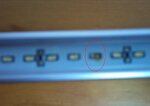d123
Advanced Member level 5
Hi,
Was asked to look at this LED strip light, a low power replacement for flourescents, I know it was ...inexpensive..., not top of the range. This is the second out of three of these that have broken in a neighbour's home.
I looked, and it has a burnt LED (a black spot in the middle of the LED, and brown mark around edges). I also took it apart out of curiosity as it's odd that two should break in a few weeks of use.
Not sure if we have voltage surges here so high as to go breaking lights but not affecting other neighbours, their house seems to function "normally" electrically speaking, ... As I'm not well-versed in repair diagnosis, I am guessing that the LEDs may not be ideally matched, or a slight surge would tip the balance and something will blow, like an LED.
I've attached a schematic of the circuit, hope it's comprehensible and haven't made any mistakes copying the track paths; also a blurry photo of the burnt LED (maybe I'm wrong about it being burnt) and a photo of the ultra high-tech AC mains to DC circuit inside the strip light.
I wonder if the LEDs are bi-directional white LEDs, I'm having difficulty otherwise seeing how this circuit works. I used the symbol for a single LED as I have no idea how these little white and yellow rectangle LEDs are on the inside.
a) What may (appreciating it is guessing) be the cause(s) for two out of three fails in few weeks of use?
b) I don't know how to phrase this question, but, let's try with: Is the diode rectifier alone a normal way of powering this type of lighting?



Thanks
Was asked to look at this LED strip light, a low power replacement for flourescents, I know it was ...inexpensive..., not top of the range. This is the second out of three of these that have broken in a neighbour's home.
I looked, and it has a burnt LED (a black spot in the middle of the LED, and brown mark around edges). I also took it apart out of curiosity as it's odd that two should break in a few weeks of use.
Not sure if we have voltage surges here so high as to go breaking lights but not affecting other neighbours, their house seems to function "normally" electrically speaking, ... As I'm not well-versed in repair diagnosis, I am guessing that the LEDs may not be ideally matched, or a slight surge would tip the balance and something will blow, like an LED.
I've attached a schematic of the circuit, hope it's comprehensible and haven't made any mistakes copying the track paths; also a blurry photo of the burnt LED (maybe I'm wrong about it being burnt) and a photo of the ultra high-tech AC mains to DC circuit inside the strip light.
I wonder if the LEDs are bi-directional white LEDs, I'm having difficulty otherwise seeing how this circuit works. I used the symbol for a single LED as I have no idea how these little white and yellow rectangle LEDs are on the inside.
a) What may (appreciating it is guessing) be the cause(s) for two out of three fails in few weeks of use?
b) I don't know how to phrase this question, but, let's try with: Is the diode rectifier alone a normal way of powering this type of lighting?



Thanks